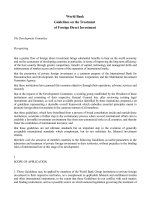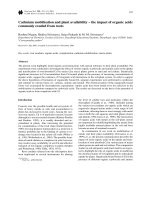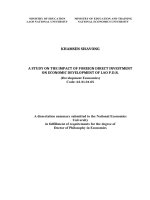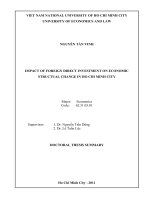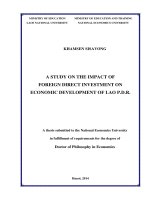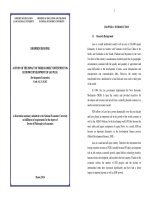Sustainable Globalization and Emerging Economies: The Impact of Foreign Direct Investment in Thailand
Bạn đang xem bản rút gọn của tài liệu. Xem và tải ngay bản đầy đủ của tài liệu tại đây (61.62 KB, 14 trang )
371
Sustainable Globalization and Emerging Economies: The Impact of Foreign Direct
Investment in Thailand
Werner Soontiens Siriporn Haemputchayakul
Curtin University of Technology, Australia
Abstract
Foreign direct investment is often considered as simultaneously being one of the consequences and drivers of
globalisation. In the process of opening up economies to participate in some of the positive impacts of globalisation,
countries position themselves in respect of attracting foreign direct investment. In addition, the ability to attract
foreign direct investment and its positive impact in growing economies is valued as an integral part of the road to
successful economic growth and development.
The Asian economic crisis has highlighted the vulnerability and volatility of emerging economies especially
in the financial sector and, in the case of Thailand, directly linked to foreign direct investment. The question that
prevails is to what extent does foreign direct investment support or sabotage globalisation attempts by countries.
This paper considers the role and impact that foreign direct investment (FDI) has had in Thailand over the
past decade. The first section identifies the nature and impact of FDI in general, followed by an explanation of the
underlying reasons for the flow of funds. The nature and impact of FDI defines the concept and summarizes the
consequences, both positive and negative, towards the recipient country. Different theories explaining why FDI takes
place are also discussed here.
The second section briefly considers foreign direct investment in Asia. This section looks at tendencies in
the flow of foreign direct investment in terms of target markets and industries. The role of FDI in Asia is analysed
over the 1990 to 1998 period to show its behaviour before and during the Asian financial crisis.
The third section analyses the impact of foreign direct investment in Thailand by pointing out its nature and
origin in terms of the major sources of FDI and the industries most affected by them. Also included in this part is the
relationship between foreign direct investment and the export performance of Thailand and the transfer of
technology impact thereof.
The last section discusses the current situation of foreign direct investment in Thailand and anticipates
future trends. This is done by assessing the impact on FDI of the recent change in political leadership and its
redefining of priorities. A brief comparison to other countries in the region and possible future trends conclude the
paper.
The Nature and Impact of Foreign Direct Investment (FDI)
When considering cross border investment, it is important to distinguish between FDI, Foreign Portfolio
Investment (FPI) and other types of foreign investment. The World Trade Organization (WTO) indicates that
"FDI occurs when an investor based in one country (the home country) acquires an asset in another country (the
host country) with the intent to manage that asset" (The South Centre, 1997: 1). Interpreting this definition from
a more specific perspective means that ownership of 10 percent or more of ordinary shares or voting power
represents a sufficient share to give the foreign investor a significant influence on the management of the
enterprise (Framework for the Collection, Compilation and Dissemination of Foreign Direct Investment
Statistics, 2000). In addition, FDI is considered to comprise three possible components; new equity from the
parent company to the subsidiary; reinvested profits of the subsidiary; and long and short term net loans from
the parent to the subsidiary (Salvatore, 2001).
Foreign Portfolio Investment (FPI), in turn, entails passive holdings of securities and other financial
assets, which do not reflect active management or control of the security's issuer. FPI is positively influenced by
high rates of return and reduction of risk through geographic diversification. The management dimension is
what distinguishes FDI from FPI in foreign stocks, bonds and other financial instruments (Krugman and
Obstfeld, 1997; Yarbrough and Yarbrough, 1997; Salvatore, 2001).
As a positive, FDI brings capital flows that improve the balance of payments, and other economic
benefits such as employment, export markets, technology, management skill enhancement and spillover effects
(Klein, Aaron and Hadjimichael, 2001). Potential negative consequences of FDI include inappropriate
technology transfer and a deteriorating balance of payments in the longer run (Kumar, 1998; Chen, 2000).
372
Within FDI, there are often trade-offs between different benefits and objectives. Countries may, for instance,
have to choose between investments that offer short as opposed to long-term benefits; foreign firm involvement
may lead to static gains but not necessarily to dynamic ones, such as infrastructure and living standards. A large
inflow of FDI can add to investment resources in a host economy but it may deter the development of local
firms. The desire to generate employment may lead governments to favor labor intensive, low technology
investments, while promotion of technology development may favor more sophisticated investors. Similarly, the
desire to upgrade technology may call for a heavy reliance on technology transfer by foreign investors, while to
promote local innovation may require more emphasis on arm's length transfers to local firms. There can be
many such trade-off, and there is no universal answer to how they should be made. Thus, there is no ideal policy
on FDI, which applies to all countries at all times (OECD, 1999b).
Rather than determining whether FDI is good or bad for economic development the focus should be on
ensuring that it contributes in a balanced and sustainable way to the legitimate aspirations of host countries.
Some foreign investors acknowledge that investment decisions and performance in host countries could have
both positive and negative impacts on the local economy depending on policies of host countries (IFC, 1997).
To examine motives of FDI makers, the following section reviews some theories.
Explaining Foreign Direct Investment flows
Theories explaining FDI assert that the basis for such investment lies in the transaction cost of transferring
technical and other knowledge and market imperfections. Subsequently in a world of perfect markets, there
would be no Multinational Enterprises (MNEs) and, thus no FDI as it is MNEs that make FDI (Goldar and
Ishigami, 1999). The most important theories explaining FDI are the following:
Comparative Cost Advantage Theory
According to the theory of comparative cost advantage (explaining the nature of imperfect markets), "a country
should produce and export those goods and services for which it is relatively more productive than other
countries and import those goods and services for which other countries are relatively more productive than it
is" (Krugman and Obstfeld, 1997: 168). This is, however, "not a sufficient condition for FDI since the
significance of investment flows concerns other conditions such as technology transfer, tax incentives and
explanations of trade flows, rather than country-based theories" (Griffin and Pustay, 1999: 89).
Product Life Cycle Theory
The Product Life Cycle Theory explains why MNEs undertake FDI at particular stages in the life cycle of a
product they have pioneered. FDI will occur when the foreign market is large enough to support local
production (Cullen, 1999; Griffin and Pustay, 1999). However, the theory does not identify clearly when it is
profitable to invest in activities (Hill, 2001), and it also fails to explain why companies choose FDI over other
forms of market entry, such as direct exporting (Wild, Wild and Han, 2000).
Internalization Theory
The Internalization theory, or market imperfection theory, states that "when an imperfection in the market
makes a transaction less efficient than it could be, a company will undertake FDI to internationalize the
transaction and thereby remove the imperfection" (Wild, Wild and Han, 2000: 230). The theory also explains
why firms prefer FDI to licensing, as licensing has weaknesses, including exposing technological know-how to
foreign competitors, absence of control over manufacturing, marketing, and strategy in a foreign country. In
addition, a firm's uniqueness and competitive advantage may not be amenable for licensing (Foreign Direct
Investment and Its Political Economy, 2000).
The Eclectic Paradigm Theory
The Eclectic Paradigm theory explains both the ways in which overseas markets are served by enterprises of
different nationalities and the industrial and geographical composition of such activities (Wild, Wild and Han,
373
2000). According to this theory, a firm will make a direct investment in a foreign country if the following three
conditions are satisfied. "First, the firm must have a product or a production process such that the firm enjoys
some market power advantage in foreign markets. Second, the firm must have a reason to locate production
abroad rather than concentrate it in the home country, especially if there are scale economies at the plant level.
Third, the firm must have a reason to exploit its ownership advantage internally, rather than license or sell its
process to a foreign firm" (Markusen, 2000: 3). The theory furthermore suggests that all forms of international
production can be explained by reference to these conditions. Location or country specific advantages have an
important bearing on FDI often rendering the location preferable to other potential host countries, and to
domestic investment. Another determinant of FDI is the ability of the firm to generate ownership advantages,
which are best exploited by the firm in a foreign rather than in a domestic location. In this way, the eclectic
theory is able to provide an explanation for differences in the industrial pattern of outward FDI of different
industrialized countries (Goldar and Ishigami, 1999; Wild, Wild and Han, 2000).
Market Power Theory
The Market Power Theory states that FDI will occur when a company tries to establish a dominant market
presence in an industry. In this theory, the firm will get more profit because it is far better able to dictate the cost
of its inputs and the price of its output. Companies that are able to achieve a great deal of market power can
integrate forward to increase control over output (Wild, Wild and Han, 2000).
As has been reviewed in this section, there are a number of theories that attempt to explain the flow of
FDI. The Eclectic Paradigm theory is the most useful for analyzing the implication of FDI in economic
development. The next section will discuss the flow of FDI to Asian countries.
Foreign Direct Investment in Asia
The Asian countries most affected by the Asian financial crisis have ranked high among developing host
countries in the attractiveness of their economies to foreign investors. In particular, they have substantially
liberalized their FDI policies and taken steps to facilitate business. However, the financial crisis and economic
consequences will affect FDI flows to these countries. Thus, the tendencies and role of FDI will be discussed as
following.
Tendencies
The pattern of FDI flows into and within Asian countries has had some structural changes since 1990. The
change is attributed to two reasons; globalization and mergers and acquisitions (M&A) (Wild, Wild and Han,
2000). Firstly, increased globalization and lower trade barriers cause a growing number of international
companies to undertake FDI, as companies realize they can produce in a more efficient and productive location
in the world, and simply export to a worldwide market. This set off another round of FDI flows into low-cost
newly industrialized and emerging nations worldwide (Bishop, 1997).
Second, the number of M&A and their exploding values also underline the change in pattern of FDI
flows. Many cross-border M&A deals are driven by the desire of companies to get a foothold in a new
geographic market, to increase a firm's global competitiveness, to fill gaps in companies' product lines in a
global industry and to reduce costs in such areas as R&D, production, or distribution (Cullen, 1999; Wild, Wild
and Han, 2000). As a result, FDI in the primary sector continues to experience a declining share with a greater
distribution of FDI flows to the manufacturing and the tertiary sector. FDI in finance and banking activities
increased noticeably in the second half of the 1990s, particularly through M&A (Kaiser, Kirton and Daniels,
2000). The financial sector liberalization process undertaken by countries in the region facilitates this
development. These structural changes are partly due to the industrial development policies of the countries in
the region, which aim to diversify economies from over reliance on agriculture. The developmental progress
made in the manufacturing and financial sector further facilitates this process (Overview of Foreign Direct
Investment in ASEAN, 2000).
374
Role
FDI has contributed significantly to the economic and industrial development of the Asian countries over many
years and is expected to continue to do so (Bottelier, 1998). Among the components of resource flows to Asian
countries, FDI constitutes a considerable share, indicating the importance of FDI as a major source of finance
for economic development. Moreover, most of the FDI flows played an important role in pushing the export
sector of those countries (Asian Development Bank, 2001a). A large number of these, including Thailand, gave
priority to export as a key mechanism for economic development (Suksiriserekul, 2000). Nevertheless, Taiwan
and South Korea did not resort to FDI as the impetus for exports and instead relied on the promotion of
entrepreneurs to develop products for sales abroad. The countries that relied on FDI and consequently grew, also
experienced an increase in their trade deficits (Bangkok Bank, 2000).
Between 1990 and 1997, FDI represented about an annual average of 40% of the net resource flows to
the Asian countries (see Table 1, Figure 1). A high ratio of FDI to net private capital flows in the 1990s is the
norm for most developing countries, and particularly Asian countries (Overview of Foreign Direct Investment in
ASEAN, 2000). The Asian financial crisis has caused many countries to experience a severe shortage of funds
and managing FDI has become a factor that governments have become more aware of. This is partly due to the
role FDI played in bringing about an economic expansion in Asia (United Nations, 1999).
Table 1: PRIVATE FLOWS TO ASIAN COUNTRIES, BETWEEN 1990-1997 (US$ BILLION)
Type of Investment
US$ (billion)
Percentage
of
1990 1991 1992 1993 1994 1995 1996 1997 Total
(90-97)
net flow
Official Development
Finance
50 60 50 50 35 50 30 40 365 22.5
Foreign Direct
Investment
30 45 50 75 90 105 120 120 635 40
Debt Flows 15 15 30 35 31 60 80 100 366 23
Portfolio Equity Flows 5 7 10 50 40 30 50 40 232 14.5
Source: Adapted from the World Bank, 1998.
Figure1: Private Flows to Asian Countries, between 1990-1997, (US$ billion)
Source: Adapted from the World Bank, 1998.
Official
Development
Finance
Foreign Direct
Investment
Debt Flows
Portfolio Equity
Flows
0
50
100
150
200
250
300
350
1990 1991 1992 1993 1994 1995 1996 1997
375
As part of the increased awareness governments changed laws and regulations to attract FDI.
Previously protected business sectors for local entrepreneurs were opened up to foreign investors, particularly
the financial institution sector (Singh, 1999). FDI is expected to continue to be a significant source of finance
for development in the Asian countries, against the backdrop of the decline in official development assistance
and difficult access to international debt markets and bank borrowing in recent times (Chen, 2000; Overview of
Foreign Direct Investment in ASEAN, 2000).
An outstanding characteristic of FDI is that it is more stable than other kinds of international capital
flows. This is confirmed by the flow of capital during the Asian financial crisis. In countries affected by the
financial crisis, portfolio flows and other investment flows have shifted from highly positive to strongly
negative, while FDI flows remained positive (see Table 2). The size and the suddenness of the reversal in non-
FDI flows in some countries, as reflected in Table 3, has triggered and magnified the financial crisis in Asia
(Bottelier, 1998). In addition, FDI has appeared to be an increasingly attractive alternative to long-term bank
loans as a form of capital inflow for developing countries, and has been viewed by some as the remedy for
declining domestic investment and higher costs of borrowing from abroad (Mbekeani, 1997).
Table 2: NET PRIVATE CAPITAL FLOWS TO FIVE AFFECTED ASIAN COUNTRIES
(Thailand, Philippines, Malaysia, Korea, Indonesia)
US$ billion 1996 1997 1998
Net Foreign direct investment 9.5 12.1 4.9
Net Portfolio investment 2.0 12.6 -6.5
Bank Loans and Other 32.9 -44.5 -44.5
Source: IMF cited in Bangkok Bank, 2000.
Table 3: GLOBAL NET FLOWS TO SELECTED ASIAN COUNTRIES AS A PROPORTION OF GDP
1994 1995 1996 1997 1998
Indonesia FDI 1.2 2.2 2.8 2.2 -0.2
FPI 2.2 2.0 2.2 -1.2 -2.0
OI -0.9 1.2 0.1 -1.1 -4.7
Korea FDI 0.2 0.4 0.5 0.6 1.7
FPI 2.2 3.1 4.4 2.8 -0.1
OI 3.6 4.7 5.1 -1.9 -5.0
Thailand FDI 1.0 1.2 1.3 2.4 6.4
FPI 1.7 2.4 2.0 3.1 0.3
OI 6.9 11.6 6.5 -14.5 -16.8
Malaysia FDI 6.1 4.9 5.1 5.2 NA
FPI -2.3 -0.5 -0.3 -0.3 NA
OI -2.7 5.5 4.6 -1.2 NA
TOTAL FDI 1.1 1.4 1.6 1.8 2.1
FPI 1.7 2.4 3.0 1.6 -2.0
OI 2.6 5.3 4.2 -3.7 -8.3
Source: The International Financial Institutions and World Resources Institutions cited in Cailloux and Jones,
1999.
Foreign Direct Investment in Thailand
FDI in Thailand has been a major contributor to Thailand's economic growth since the mid-1980s (Indian Ocean
Rim Network, 2000). In the late 1980s, about 50% of FDI inflow went to the manufacturing sector, especially in
the area of labor intensive and export-oriented industries. Despite this Thai industry became less competitive
during the 1990s, the real estate sector boomed and investment in private infrastructure increased in 1993. This
structural change shifted FDI from manufacturing to real estate and infrastructure (Commonwealth of Australia,
2000). From 1993 to 1996, almost 40% of net FDI in Thailand went to real estate (Figure 2).


